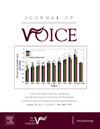通过内窥镜缩短声带褶皱提高声带音高的两种手术技术比较
IF 2.5
4区 医学
Q1 AUDIOLOGY & SPEECH-LANGUAGE PATHOLOGY
引用次数: 0
摘要
目的:比较两种手术方法:Wendler声门成形术(GP)及其改良方法、声带缩短术、前会厌后移术(VFSRAC)和激光辅助嗓音调节(LAVA)脊髓切除术,这两种方法通过提高基频(F0)使变性女性的嗓音女性化:方法:对 22 名变性女性(20-62 岁)进行了回顾性研究。其中 12 人接受了 GP 治疗,10 人接受了 VFSRAC+LAVA 技术治疗。她们在手术前、手术后 6 个月以及术后语言治疗后接受了评估。所有患者均接受了喉腔镜检查、F0测量、变性女性嗓音问卷(TWVQ)评估和使用视觉模拟量表(PA-VAS)进行的知觉评估:结果:喉息肉镜检查结果显示,术前声带正常,术后声带因声门前部闭锁而缩短。两组患者的 F0 均显著增加,但 VFSRAC+LAVA 组的 F0 增加幅度更大(GP 组为 47.75Hz vs VFSRAC+LAVA 组为 69.70Hz)。两组的 TWVQ 评分均显著下降,但 VFSRAC+LAVA 组的差异更大。同样,两组的 PA-VAS 评分都有明显下降,但 VFSRAC+LAVA 组的下降幅度最大:结论:两种手术技术都能通过内窥镜方法缩短声带,并使声音音调更高。在两种技术中,VFSRAC+LAVA 技术的效果更好,但与之前的研究相比,LAVA 技术对术后效果的影响似乎并不明显。因此,对于希望使嗓音女性化的变性女性,可以推荐使用 VFSRAC 技术,然后进行术后语音治疗。本文章由计算机程序翻译,如有差异,请以英文原文为准。
Comparison Between two Surgical Techniques for Increasing Vocal Pitch by Endoscopic Shortening of the Vocal Folds
Objective
To compare two surgical techniques, the Wendler glottoplasty (GP) and its modification, the vocal fold shortening, and retrodisplacement of the anterior commissure (VFSRAC) associated with laser assisted voice adjustment (LAVA) cordotomy, used to feminize the voice of transgender women by increasing the fundamental frequency (F0).
Methods
A retrospective study of 22 trans-women (20-62 years-old) was carried out. 12 of them were treated with GP and 10 with the VFSRAC+LAVA technique. They were evaluated before surgery and 6 months after surgery and the postoperative speech therapy. Laryngostroboscopy examination, F0 measurements, Transgender Woman Voice Questionnaire (TWVQ) assessment and the perceptual assessment using a visual analog scale (PA-VAS) were obtained from all patients.
Results
Laryngostroboscopic findings showed normal vocal folds before surgery and a shortening of the vocal folds, due to the anterior glottic synechia, after surgery. Significant increases of F0 were found in both groups but they were higher in the VFSRAC+LAVA group (47.75Hz in GP group vs 69.70Hz in VFSRAC+LAVA group). TWVQ scores showed a significant decrease in both groups although the difference was greater in the VFSRAC+LAVA group. Similarly, PA-VAS scores lowered significantly in both groups but VFSRAC+LAVA group presented the biggest decreases.
Conclusion
Both surgical techniques produce the shortening of the vocal folds through an endoscopic approach and result in voices with higher vocal pitch. Of the two techniques presented, the VFSRAC+LAVA produces better results although when compared with previous studies it seems that the LAVA technique may not significantly contribute to the postoperative results. So, the VFSRAC technique followed by postoperative speech therapy could be recommended for trans-women who wish to feminize their voice.
求助全文
通过发布文献求助,成功后即可免费获取论文全文。
去求助
来源期刊

Journal of Voice
医学-耳鼻喉科学
CiteScore
4.00
自引率
13.60%
发文量
395
审稿时长
59 days
期刊介绍:
The Journal of Voice is widely regarded as the world''s premiere journal for voice medicine and research. This peer-reviewed publication is listed in Index Medicus and is indexed by the Institute for Scientific Information. The journal contains articles written by experts throughout the world on all topics in voice sciences, voice medicine and surgery, and speech-language pathologists'' management of voice-related problems. The journal includes clinical articles, clinical research, and laboratory research. Members of the Foundation receive the journal as a benefit of membership.
 求助内容:
求助内容: 应助结果提醒方式:
应助结果提醒方式:


